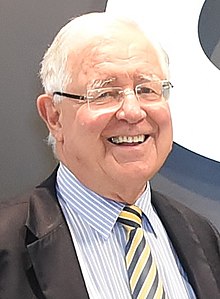Sir Richard Lewis Maxwell Faull KNZM FRSNZ (born 21 October 1945) is a New Zealand neuroscientist and academic who specialises in human neurodegenerative diseases. He is a professor of anatomy and director of the Centre for Brain Research at the University of Auckland.[1]

Biography
editFaull is of Ngāti Rāhiri and Te Āti Awa descent.[2] He grew up with four brothers in Tikorangi, Taranaki, where his parents, Phyllis Thelma Faull (née Rogers) and Wilfred Lewis Faull, had a general store.[3][4][5] He attended the University of Otago, earning a Bachelor's of Science in 1967 and a Bachelor of Medicine (MB ChB) in 1970. He followed that with a PhD in neuroanatomy (1975)[6] and Doctor of Science (DSc) in neuroscience (1994), both from the University of Auckland.[7] Faull and his wife, Diana, have five children.[3]
Research
editFaull is noted for his research into brain diseases, particularly Alzheimer's, Parkinson's and Huntington's diseases. In 2007, his team at the University of Auckland proved that the brain can repair itself by generating new cells, debunking the theory that, once fully formed, the human brain could only degenerate.[8][9] In 2009, he established the University of Auckland's Centre for Brain Research (CBR), to facilitate interactions among different groups and to promote new treatments for brain disease.[4]
Honours and awards
editIn 2005, Faull was awarded the Health Research Council of New Zealand's Liley Medal[10] and was appointed an Officer of the New Zealand Order of Merit, for services to medical research, in the 2005 Queen’s Birthday Honours.[11] In 2007, he was awarded the Rutherford Medal by the Royal Society of New Zealand. In the 2017 New Year Honours, he was appointed a Knight Companion of the New Zealand Order of Merit for services to medical research.[1]
In recognition of his work establishing links between the Māori community and neuroscience Faull was honoured in 2023 in a ceremony in which he received a kōrowai (cloak) and tokotoko (carved stick).[2]
Notable students
editNotable doctoral students include Bronwen Connor and Rita Krishnamurthi.[12][13]
References
edit- ^ a b "New Year Honours 2017 – Citations For Knights Companion Of The New Zealand Order Of Merit". Department of the Prime Minister and Cabinet. Retrieved 1 January 2017.
- ^ a b "Sir Richard Faull bestowed kōrowai and tokotoko for services to Māori and neuroscience". NZ Herald. 13 November 2023. Retrieved 1 December 2023.
- ^ a b "'Normality has a dullness about it' – The Listener". Noted. 18 June 2015. Retrieved 1 January 2017.
- ^ a b "Brain researcher Professor Richard Faull 'humbled' by New Year Honour". Newshub. 31 December 2016. Retrieved 1 January 2017.
- ^ Taylor, Alister; Coddington, Deborah (1994). Honoured by the Queen – New Zealand. Auckland: New Zealand Who's Who Aotearoa. p. 139. ISBN 0-908578-34-2.
- ^ Faull, Richard (1975). Studies on the projections of the superior cerebellar peduncle and the rubrothalamic and nigrothalamic projections in the rat, and their relevance to the homologies of the anterior parts of the ventral nucleus of the thalamus in the mammalian brain (Doctoral thesis). ResearchSpace@Auckland, University of Auckland. hdl:2292/3103.
- ^ "University of Auckland, abridged academic CV" (PDF). Retrieved 1 January 2017.
- ^ "Professor Richard Faull". Neurological Foundation of New Zealand.
- ^ "Episode 3 – Mind matters". Radio New Zealand. 13 July 2016. Retrieved 1 January 2017.
- ^ Taylor, Phil (15 December 2007). "Richard Faull: Neuroscientist". The New Zealand Herald. Retrieved 1 January 2017.
- ^ "Queen's Birthday honours list 2005". Department of the Prime Minister and Cabinet. 6 June 2005. Retrieved 28 April 2020.
- ^ Connor, Bronwen Jane (1997). The role of neurotrophic factors in neurodegenerative disorders of the human brain (PhD thesis). ResearchSpace@Auckland, University of Auckland.
- ^ Krishnamurthi, Rita (2006). Treatment Effects of the N-terminal tripeptide of insulin-like growth factor-1, GPE, in a Rat Model of Parkinson’s Disease (PhD thesis). University of Auckland.